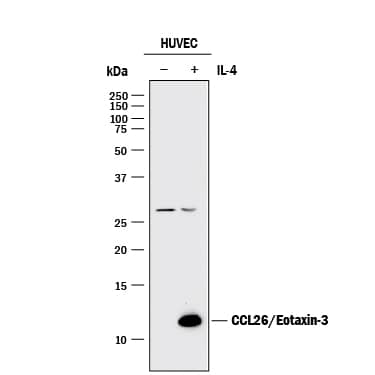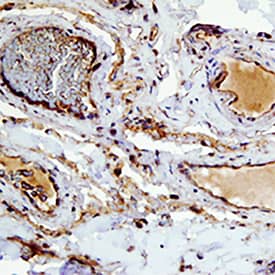Human CCL26/Eotaxin-3 Antibody Summary
Thr24-Leu94
Accession # Q9Y258
Applications
Please Note: Optimal dilutions should be determined by each laboratory for each application. General Protocols are available in the Technical Information section on our website.
Scientific Data
 View Larger
View Larger
Detection of Human CCL26/Eotaxin‑3 by Western Blot. Western blot shows lysates of HUVEC human umbilical vein endothelial cells untreated (-) or treated (+) with 100 U/mL Recombinant Human IL-4 (Catalog # 204-IL) for 24 hours. PVDF membrane was probed with 1 µg/mL of Goat Anti-Human CCL26/Eotaxin-3 Antigen Affinity-purified Polyclonal Antibody (Catalog # AF653) followed by HRP-conjugated Anti-Goat IgG Secondary Antibody (Catalog # HAF017). A specific band was detected for CCL26/ Eotaxin-3 at approximately 12 kDa (as indicated). This experiment was conducted under reducing conditions and using Immunoblot Buffer Group 1.
 View Larger
View Larger
CCL26/Eotaxin‑3 in Human Colon (Vasculature). CCL26/Eotaxin‑3 was detected in immersion fixed paraffin-embedded sections of human colon (vasculature) using Goat Anti-Human CCL26/Eotaxin‑3 Antigen Affinity-purified Polyclonal Antibody (Catalog # AF653) at 15 µg/mL for 1 hour at room temperature followed by incubation with the Anti-Goat IgG VisUCyte™ HRP Polymer Antibody (VC004). Before incubation with the primary antibody, tissue was subjected to heat-induced epitope retrieval using Antigen Retrieval Reagent-Basic (CTS013). Tissue was stained using DAB (brown) and counterstained with hematoxylin (blue). Specific staining was localized to cell surface on endothelial cells. Staining was performed using our protocol for IHC Staining with VisUCyte HRP Polymer Detection Reagents.
 View Larger
View Larger
Chemotaxis Induced by CCL26/Eotaxin‑3 and Neutralizatio by Human CCL26/Eotaxin‑3 Antibody. Recombinant Human CCL26/Eotaxin-3 (Catalog # 346-E3) chemoattracts the BaF3 mouse pro-B cell line transfected with mouse CCR3 in a dose-dependent manner (orange line). The amount of cells that migrated through to the lower chemotaxis chamber was measured by Resazurin (Catalog # AR002). Chemotaxis elicited by Recombinant Human CCL26/Eotaxin-3 (1 µg/mL) is neutralized (green line) by increasing concentrations of Human CCL26/Eotaxin-3 Antigen Affinity-purified Polyclonal Antibody (Catalog # AF653). The ND50 is typically 4-24 µg/mL.
Preparation and Storage
- 12 months from date of receipt, -20 to -70 °C as supplied.
- 1 month, 2 to 8 °C under sterile conditions after reconstitution.
- 6 months, -20 to -70 °C under sterile conditions after reconstitution.
Background: CCL26/Eotaxin-3
Eotaxin-3, also named CCL26 or SCYA26, is a novel human CC chemokine that maps to chromosome 7q11.2, within 40 kilobases of the Eotaxin-2 loci. Eotaxin‑3/CCL26 has been shown to be constitutively expressed in the heart and ovary. In addition, low levels of Eotaxin-3/CCL26 expression can also be detected in various tissues. The expression of Eotaxin-3/CCL26 in vascular endothelial cells has been shown to be up-regulated by IL-13 and IL-4.
Eotaxin-3/CCL26 cDNA encodes a 94 amino acid (aa) residue protein with a putative signal peptide of either 23 or 26 aa residues. Recombinant Eotaxin-3/CCL26 has been produced in insect cells using a baculovirus expression system and shown to contain 71 aa residues. Recombinant Eotaxin-3/CCL26 is chemotactic for eosinophils and PHA-activated T cells. Eotaxin-3/CCL26 induces calcium flux in eosinophils as well as in CCR3-transfected cells. Eotaxin-3/CCL26 has also been shown to cross-desensitize cells to other CCR3 ligands. Both the 71 aa residue and 68 aa residue variants of recombinant Eotaxin-3 have been expressed in E. coli and found to have equal potency in inducing chemotaxis of a human CCR3-transfected cell line.
- Gou, R.F. et al. (1999) Genomics 58:313.
- Kitamura, M. et al. (1999) J. Biol. Chem. 274:27975.
- Shinkai, A. et al. (1999) J. Immunol. 163:1602.
Product Datasheets
Citations for Human CCL26/Eotaxin-3 Antibody
R&D Systems personnel manually curate a database that contains references using R&D Systems products. The data collected includes not only links to publications in PubMed, but also provides information about sample types, species, and experimental conditions.
5
Citations: Showing 1 - 5
Filter your results:
Filter by:
-
An initial investigation into endothelial CC chemokine expression in the human rheumatoid synovium.
Authors: Rump L, Mattey D, Kehoe O, Middleton J
Cytokine, 2017-09-01;97(0):133-140.
Species: Human
Sample Types: Whole Tissue
Applications: IHC-Fr -
Clinicopathologic Analysis of Proton Pump Inhibitor-Responsive Esophageal Eosinophilia in Korean Patients
Authors: Da Hyun Jung, Gak-Won Yun, Yoo Jin Lee, Yunju Jo, Hyojin Park
Gut and Liver
-
Proton pump inhibitors decrease eotaxin-3 expression in the proximal esophagus of children with esophageal eosinophilia.
Authors: Park, Jason Y, Zhang, Xi, Nguyen, Nathalie, Souza, Rhonda F, Spechler, Stuart J, Cheng, Edaire
PLoS ONE, 2014-07-02;9(7):e101391.
Species: Human
Sample Types: Whole Tissue
Applications: IHC -
High Levels of CCL26 in Blister Fluid and Sera of Patients with Bullous Pemphigoid.
Authors: Kagami S, Kai H, Kakinuma T
J. Invest. Dermatol., 2011-09-01;132(1):249-51.
Species: Human
Sample Types: Whole Tissue
Applications: IHC-P -
15LO1 dictates glutathione redox changes in asthmatic airway epithelium to worsen type-2 inflammation
Authors: Nagasaki T, Schuyler AJ, Zhao J Et al.
The Journal of clinical investigation
FAQs
No product specific FAQs exist for this product, however you may
View all Antibody FAQsReviews for Human CCL26/Eotaxin-3 Antibody
There are currently no reviews for this product. Be the first to review Human CCL26/Eotaxin-3 Antibody and earn rewards!
Have you used Human CCL26/Eotaxin-3 Antibody?
Submit a review and receive an Amazon gift card.
$25/€18/£15/$25CAN/¥75 Yuan/¥2500 Yen for a review with an image
$10/€7/£6/$10 CAD/¥70 Yuan/¥1110 Yen for a review without an image


